Investigation of Shear Mechanical Behavior and Slip Weakening Characteristics of Rough Joints in Rock Mass
Abstract
:1. Introduction
2. Preparation of Rough Structure Sample
2.1. Rough Structure Sample Making and 3D Laser Scanning
- (1)
- Reference mark points pasted onto the sample’s surface.
- (2)
- Scanning the rough structural surface with a 3D laser scanner.
- (3)
- Processing the point cloud data of the rough structural surface.
2.2. Calculation of Structural Surface Roughness
3. Experimental Design
3.1. Experimental Equipment and Scheme Design
3.2. Experimental Process and Purpose
- (1)
- The self-made cutter head tool was used to split the rock sample to form a structural plane with a natural rough morphology.
- (2)
- The rough structural surface was scanned by a three-dimensional laser to obtain the point cloud data of the rough structural surfaces, and the relevant data were processed to calculate the roughness of the rough structural surfaces before direct cutting.
- (3)
- Direct shear tests were carried out on surfaces with different roughness levels and under normal stress conditions. Moreover, the characteristic physical and mechanical parameters of the structural planes, that had different roughness levels, and which were subjected to normal stress conditions, were studied. The acoustic emission data during direct shearing were monitored, and the shear slip law and acoustic emission characteristics of structural planes, that had different roughness levels, and which were subjected to normal stress conditions, were analyzed.
- (4)
- The three-dimensional laser scanning of the rough structural surfaces after direct shearing was carried out again, and the attenuation law of roughness after direct shearing was calculated, noting the different roughness levels of the surfaces, and that they were subjected to normal stress conditions and a shear rate. The slip weakening characteristics of the rough structural surfaces were analyzed quantitatively. Combined with electron microscope scanning technology, the meso-damage characteristics of the rough structural planes after direct shearing were studied.
4. Experimental Results
4.1. Mechanical Properties of Structural Planes with Different Roughness Levels, under Normal Stress Conditions
4.2. Shear Acoustic Emission Characteristics of Structural Planes with Different Roughness Levels, under Normal Stress Conditions
4.3. Slip Weakening Characteristics of Structural Planes under Different Normal Stress Conditions
4.4. Slip Weakening Law of Structural Planes with Different Roughness Levels and Normal Stress Conditions
5. Conclusions
- (1)
- The shear strength and shear stress drop of a rough structural plane increases as the normal stress conditions and roughness levels increase. When the JRC of the structural plane is low, the shear strength of the structural plane is more affected by the normal stress conditions. Moreover, when normal stress conditions reach a high level of 14 MPa, the change in structural surface roughness has little effect on the shear strength. Given that it is affected by the high normal stress conditions and greater roughness level, the shear slip of the rough structural plane shows obvious stick slip characteristics and releases more energy.
- (2)
- The greater the normal stress or roughness level, the higher the number of acoustic emission events, and the greater the amount of energy released from acoustic emission events. Moreover, the cumulative number of acoustic emission events, and the amount of energy released from acoustic emission events, also increase significantly. When normal stress conditions reach a high level of 14 MPa, the convex body of the structural plane is damaged earlier in the process of direct shearing, and the duration of time wherein failure occurs and the convex body is damaged lasts longer; moreover, the more severe the damage to the convex body, the more energy that is released.
- (3)
- When the initial roughness of the structure is the same, the normal stress conditions increase from 2 MPa to 14 MPa, the shear failure area of the structural plane increases significantly, the wear on the sheared rock debris becomes increasingly serious, and the roughness after direct shearing decreases exponentially. The shear slip of the structural plane, which, under high normal stress conditions, has a high level of roughness, shows significant slip weakening characteristics, which is the main reason for the stick slip of the structural plane, and the reason why it releases a lot of energy.
Author Contributions
Funding
Institutional Review Board Statement
Informed Consent Statement
Data Availability Statement
Conflicts of Interest
References
- Liu, X.; Deng, Z.; Liu, Y.; Liu, S.; Lu, Y.; Han, Y. An experimental study on the cumulative damage and shear properties of rock joints under pre-peak cyclic shear loading. Chin. J. Rock Mech. Eng. 2018, 37, 12. [Google Scholar]
- Liu, T.; Li, J.; Li, H.; Li, X.; Li, N. Influence of shearing velocity on shear mechanical properties of planar filled joints. Rock Soil Mech. 2017, 38, 1967–1973, 1989. [Google Scholar]
- Du, S.; Lyu, Y.; Luo, Z.; Huang, M. Combined test system for size effect of rock joint shear strength and its primary application research. Chin. J. Rock Mech. Eng. 2022, 40, 1337–1349. [Google Scholar]
- Afsharhasani, R.; Karakouzian, M.; Farhangi, V. Effect of Competent Caliche Layers on Measuring the Capacity of Axially Loaded Drilled Shafts Using the Osterberg Test. Appl. Sci. 2020, 10, 6169. [Google Scholar] [CrossRef]
- Zadehmohamad, M.; Bazaz, J.B.; Riahipour, R.; Farhangi, V. Physical modeling of the long-term behavior of integral abutment bridge backfill reinforced with tire-rubber. Int. J. Geo-Eng. 2021, 12, 36. [Google Scholar] [CrossRef]
- Barton, N. Review of a new shear-strength criterion for rock joints. Eng. Geol. 1973, 7, 287–332. [Google Scholar] [CrossRef]
- Zhou, H.; Meng, F.; Zhang, C.; Yang, F.; Lu, J. Characteristics of shear failure of structural plane and slip rockburst. Chin. J. Rock Mech. Eng. 2015, 34, 1729–1738. [Google Scholar]
- Ge, Y.; Tang, H.; Wang, L.; Xiong, C.; Wang, D. Strain energy evolution of penetrative rock joints under shear loading. Chin. J. Rock Mech. Eng. 2016, 35, 1111–1121. [Google Scholar]
- Zhang, Y.; Wang, D.; Tang, H.; Li, C.; Yi, X. Study of shear strength characteristics of heterogeneous discontinuities using PFC2D simulation. Rock Soil Mech. 2016, 37, 1031–1041. [Google Scholar]
- Zhao, Y.; Wan, W.; Wang, W.; Wang, M.; Peng, Q. Shear numerical simulation of random morphology rock joint and nonlinear shear dilatancy model. Chin. J. Rock Mech. Eng. 2013, 32, 1666–1676. [Google Scholar]
- Jiang, Q.; Yang, B.; Liu, C.; Feng, X.; Shi, Y.; Song, L.; Wang, Q. Manufacturing of natural rock joints by engraving and analysis of wearing damage of natural rock joints under shear tests. Chin. J. Rock Mech. Eng. 2018, 37, 2478–2488. [Google Scholar]
- Du, S.; Huang, M.; Luo, Z.; Jia, R. Similar material study of mechanical prototype test of rock structural plane. Chin. J. Rock Mech. Eng. 2010, 29, 2264–2270. [Google Scholar]
- Xia, H.; Li, Y.; Zhou, G. Physical experiment and numerical simulation of sand-structure interface’s direct shear. J. China Univ. Min. Technol. 2015, 44, 808–816. [Google Scholar]
- Yuan, W.; Li, J. Study on the effects and its mechanism of shear rate on friction of planar joints. Chin. J. Rock Mech. Eng. 2021, 40, 3241–3252. [Google Scholar]
- GB/T 50266-2013; National Standards of People’s Republic of China: Standard for Tests Method of Engineering Rock Massas. Ministry of Housing and Urban-Rural Development of the People’s Republic of China. General Administration of Quality Supervision, Inspection and Quarantine: Beijing, China, 2013; pp. 41–53.
- Bao, H.; Zhang, G.; Lan, H.; Yan, C.; Xu, W. Geometrical heterogeneity of the joint roughness coefficient revealed by 3d laser scanning. Eng. Geol. 2019, 265, 105415. [Google Scholar] [CrossRef]
- Fan, W.; Cao, P. A new 3D jrc calculation method of rock joint based on laboratory-scale morphology testing and its application in shear strength analysis. Bull. Eng. Geol. Environ. 2020, 79, 345–354. [Google Scholar] [CrossRef]
- Tse, R.; Cruden, D.M. Estimating joint roughness coeffients. Int. J. Rock Mech. Min. Sci. Geomech. Abstr. 1979, 16, 303–307. [Google Scholar] [CrossRef]
- Yu, K.; Yao, X.; Zhang, Y.; Li, C.; Ou, L. Analysis of direct shear test data based on area and stress correction. Yanshilixue Yu Gongcheng Xuebao/Chin. J. Rock Mech. Eng. 2014, 33, 118–124. [Google Scholar]
- Du, Y.; Bao, H.; Yin, P.; Liu, C.; He, Z.; Xu, X. Study on the Anisotropic Shear Strength of Rough Joint via 3D Scanning, 3D Printing, and 3D Discrete-Element Modeling. Int. J. Geomech. 2022, 22, 04022058. [Google Scholar] [CrossRef]
- Zhang, Y.; Yang, Z.; Yao, X.; Tian, B.; Liu, X.; Liang, P. Experimental study on rockburst acoustic emission signal and fracture characteristics in granite roadway. J. China Coal Soc. 2018, 43, 95–104. [Google Scholar]
- Meng, F.; Wong, L.; Zhou, H.; Yu, J.; Cheng, G. Shear Rate Effects on the Post-peak Shear Behaviour and Acoustic Emission Characteristics of Artificially Split Granite Joints. Rock Mech. Rock Eng. 2019, 52, 2155–2174. [Google Scholar] [CrossRef]
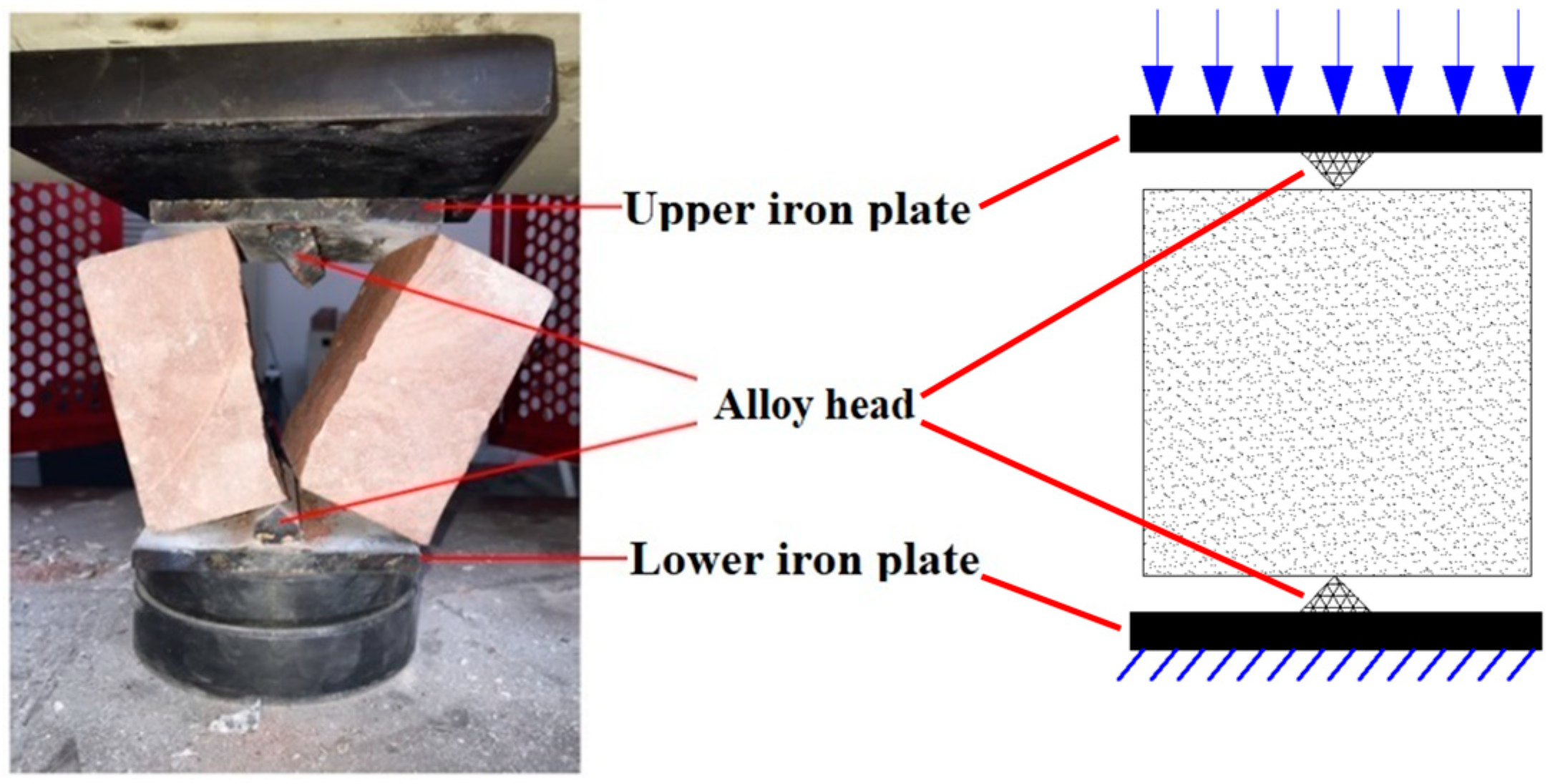
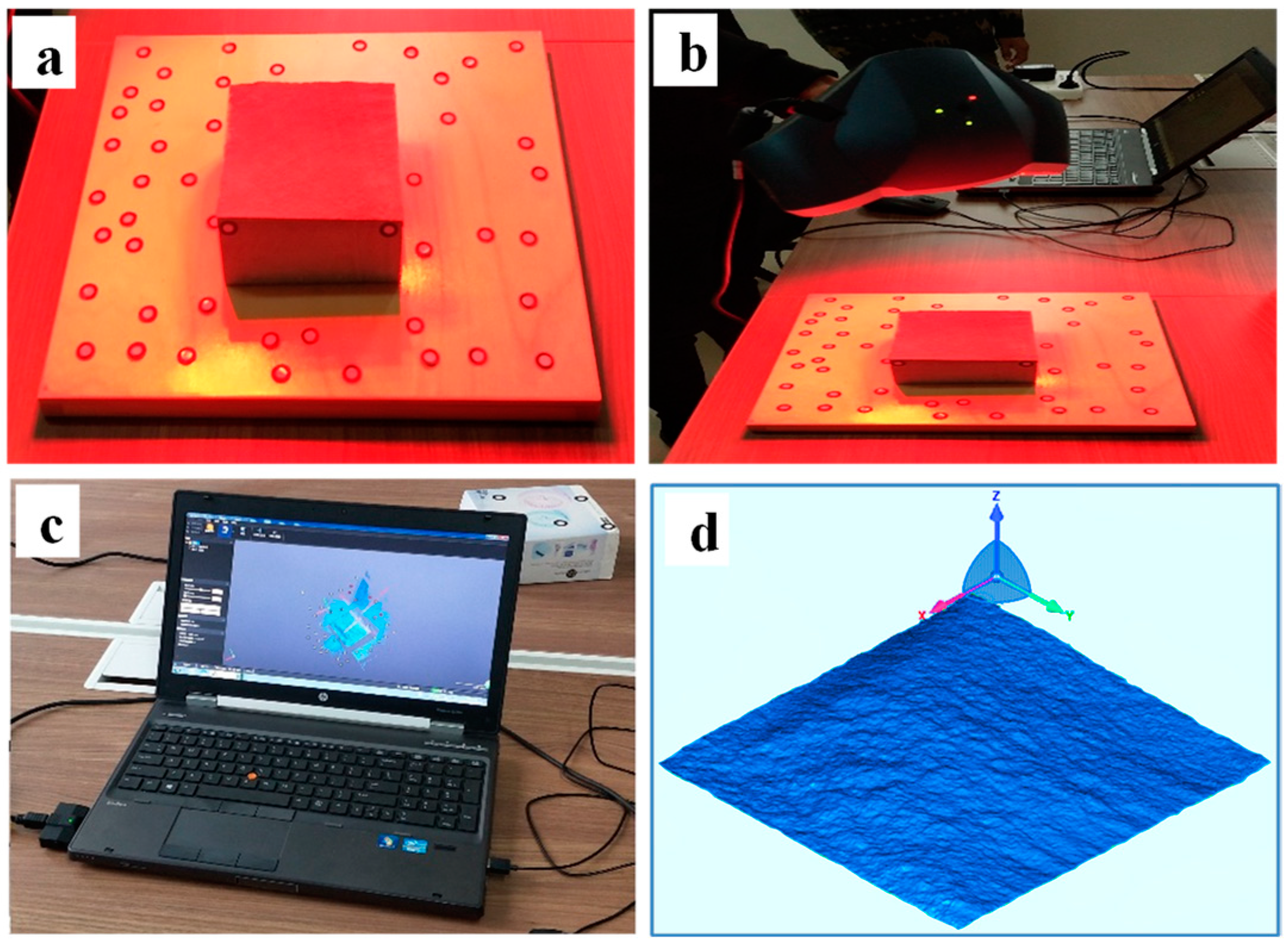
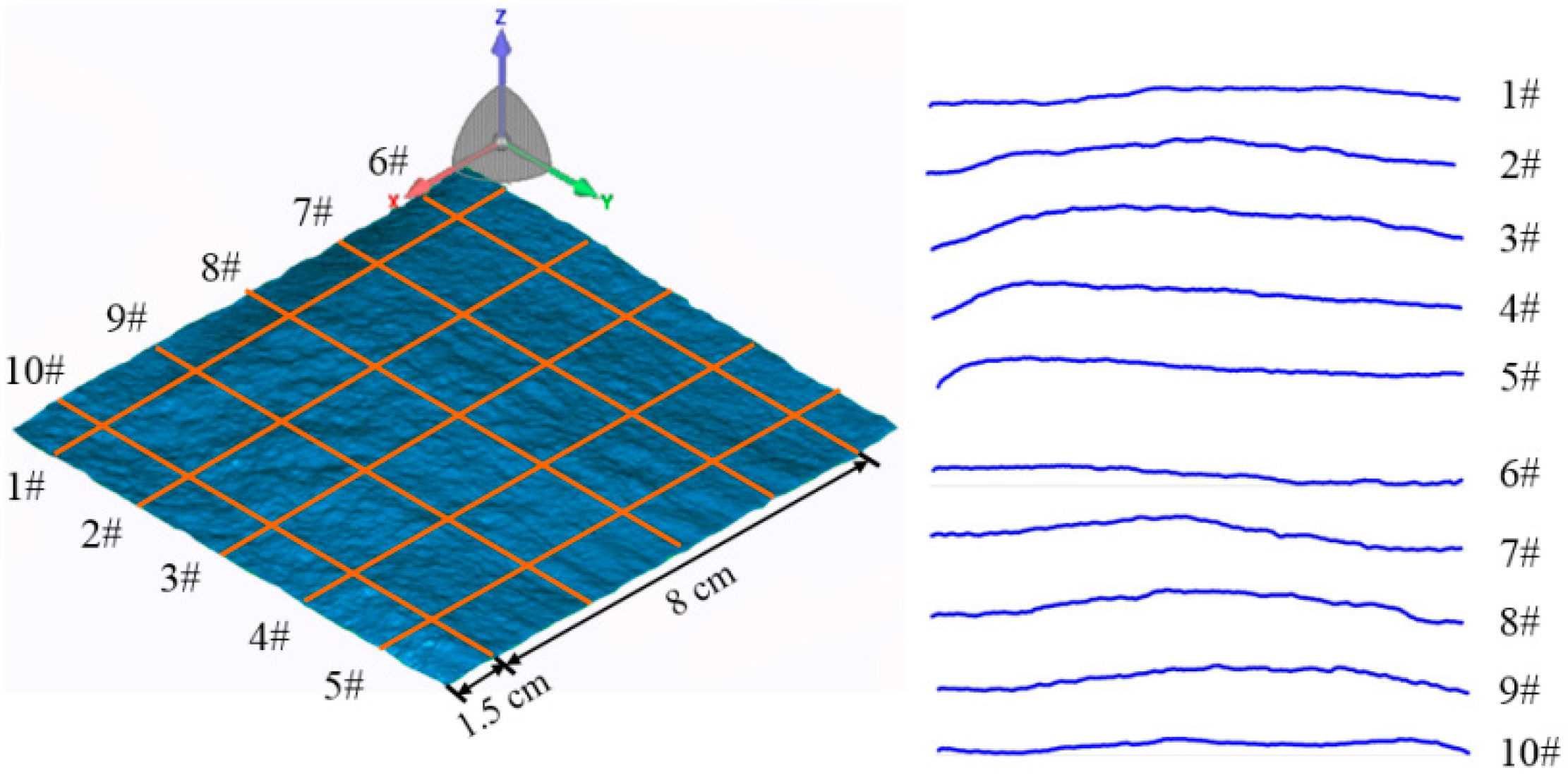

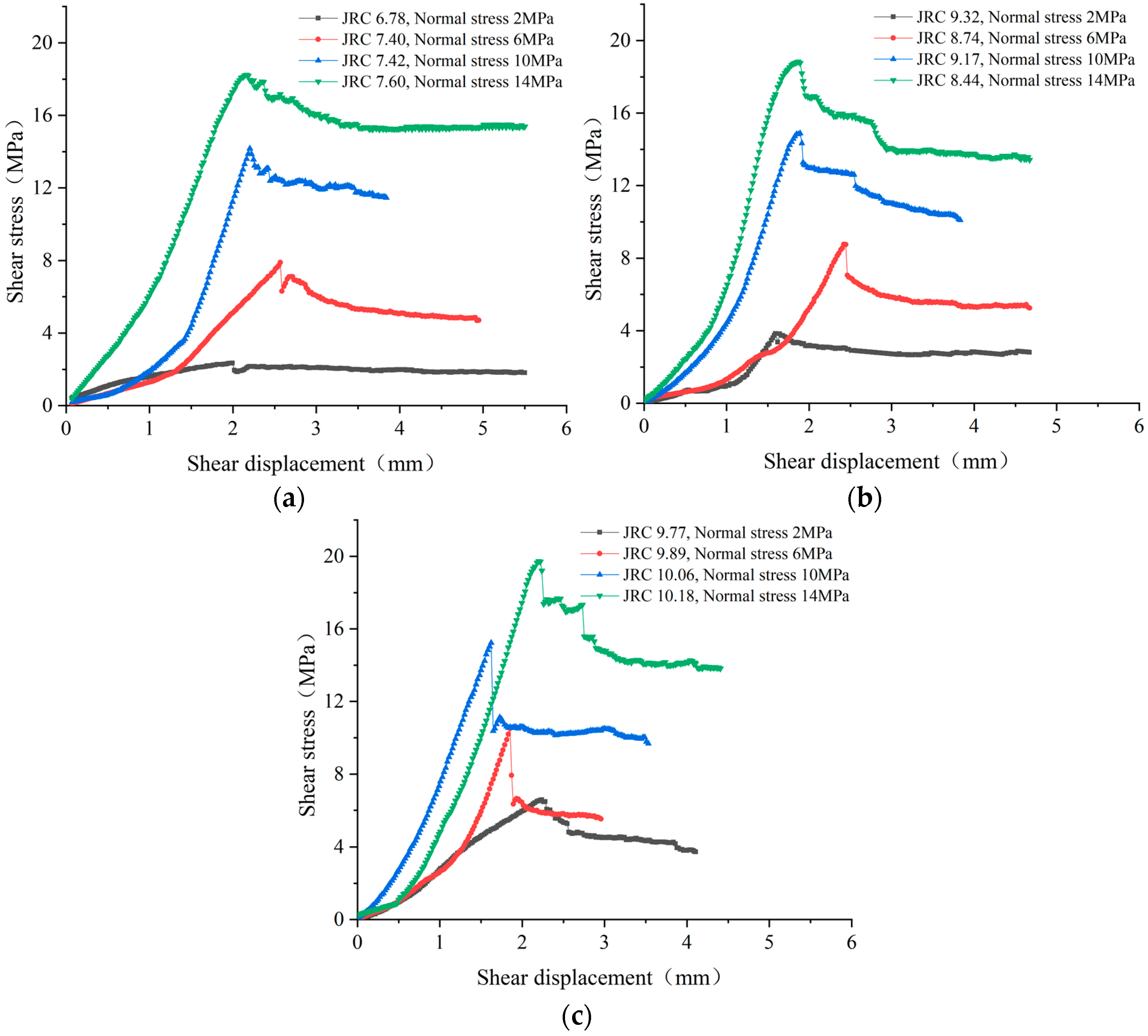




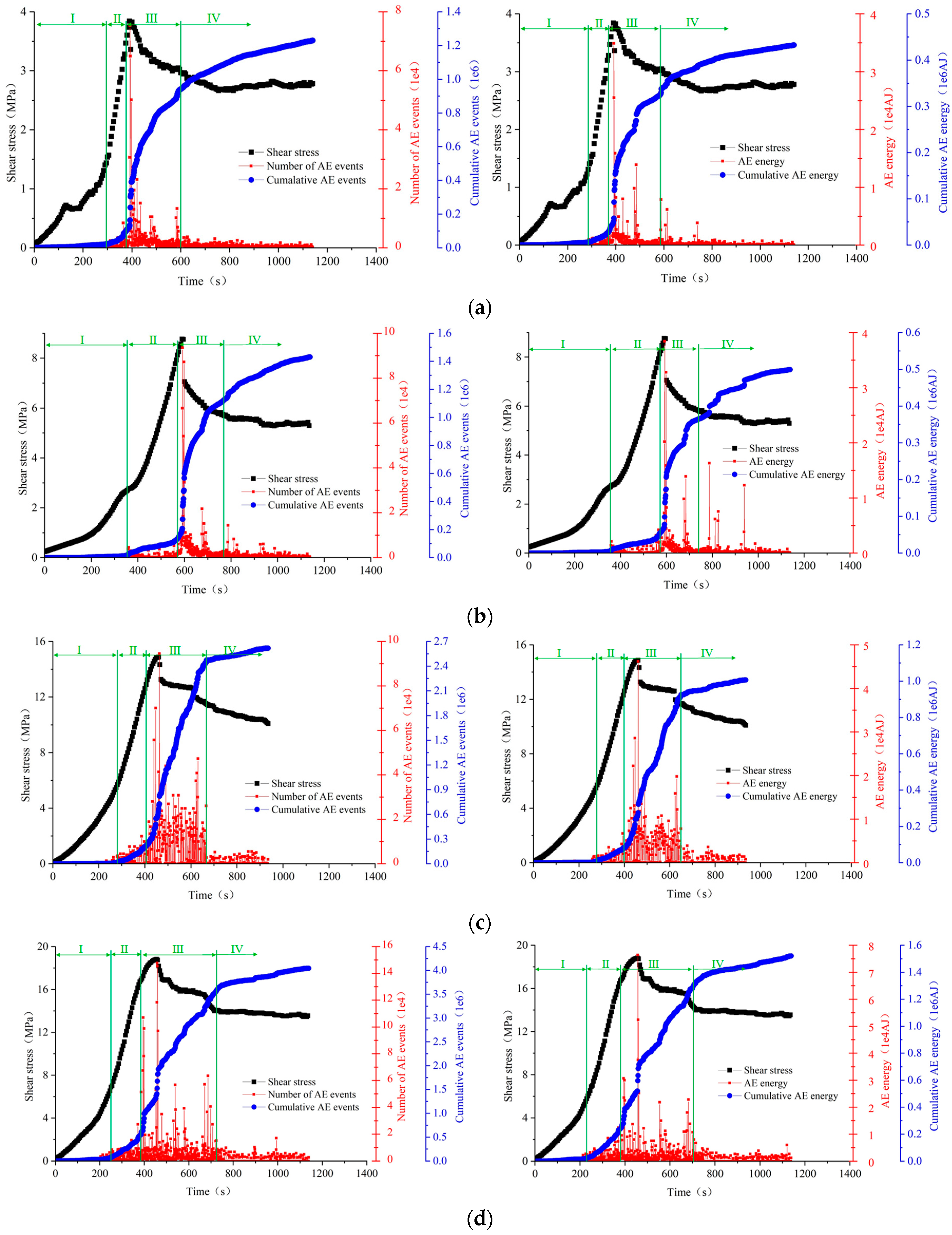
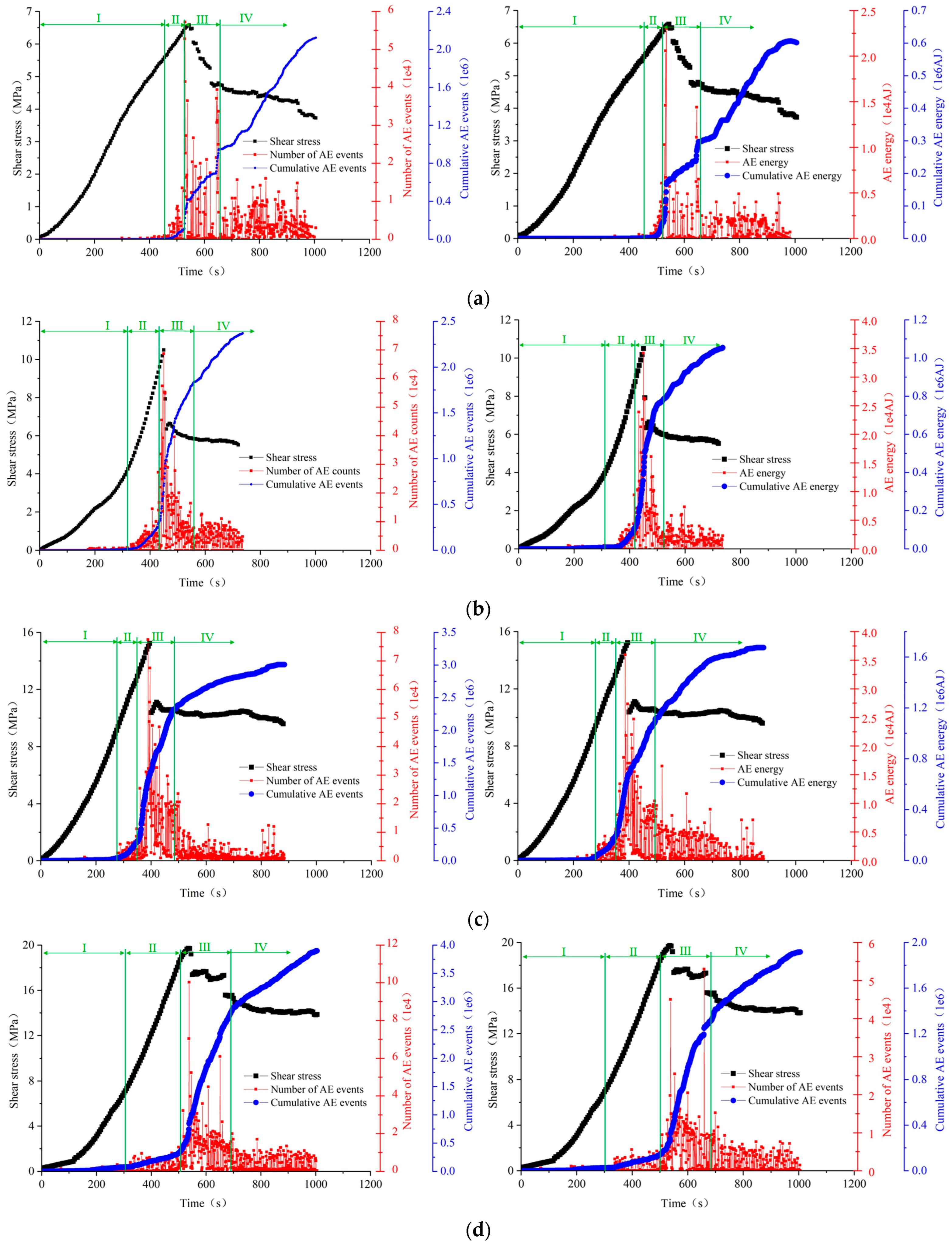
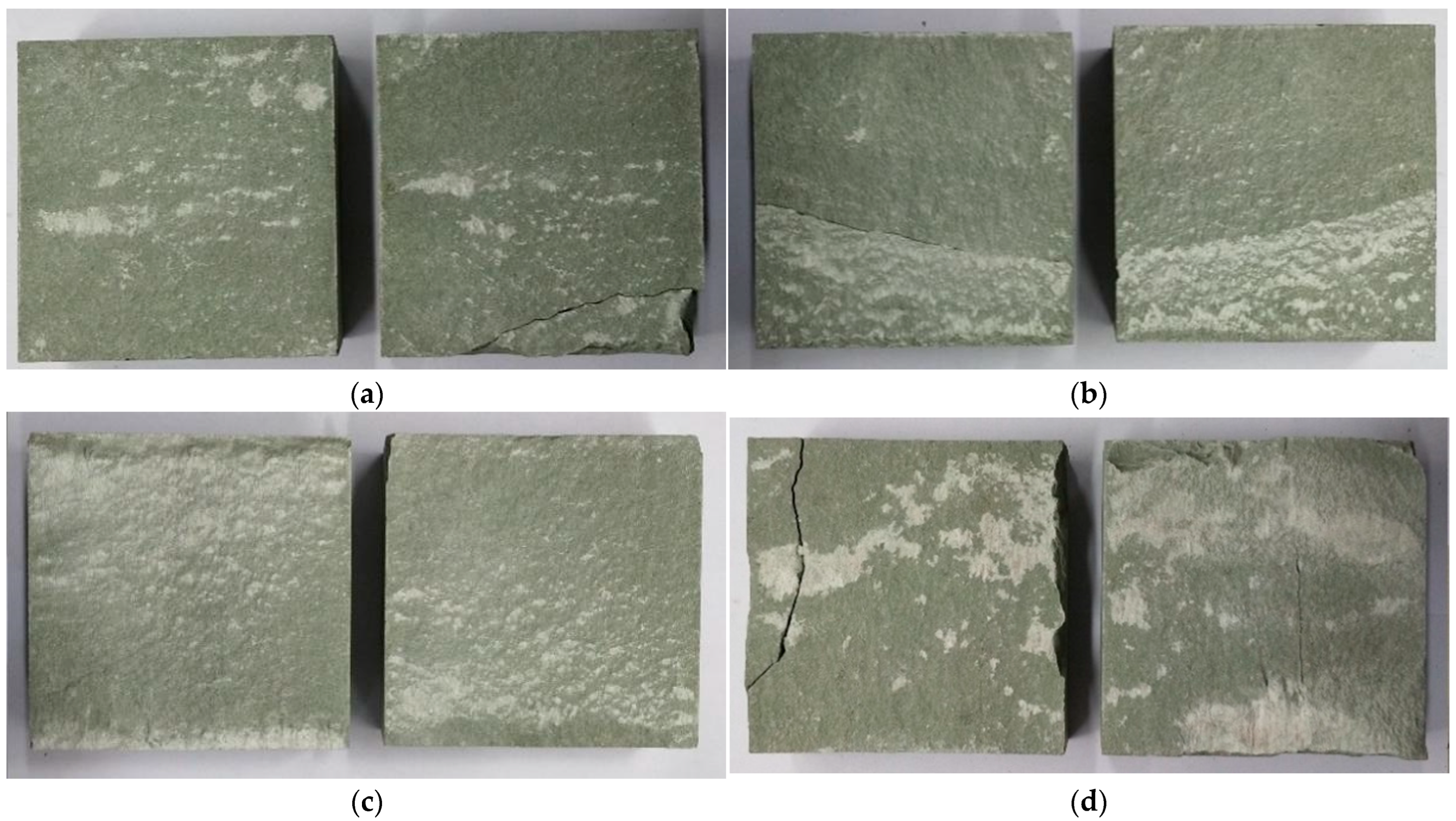
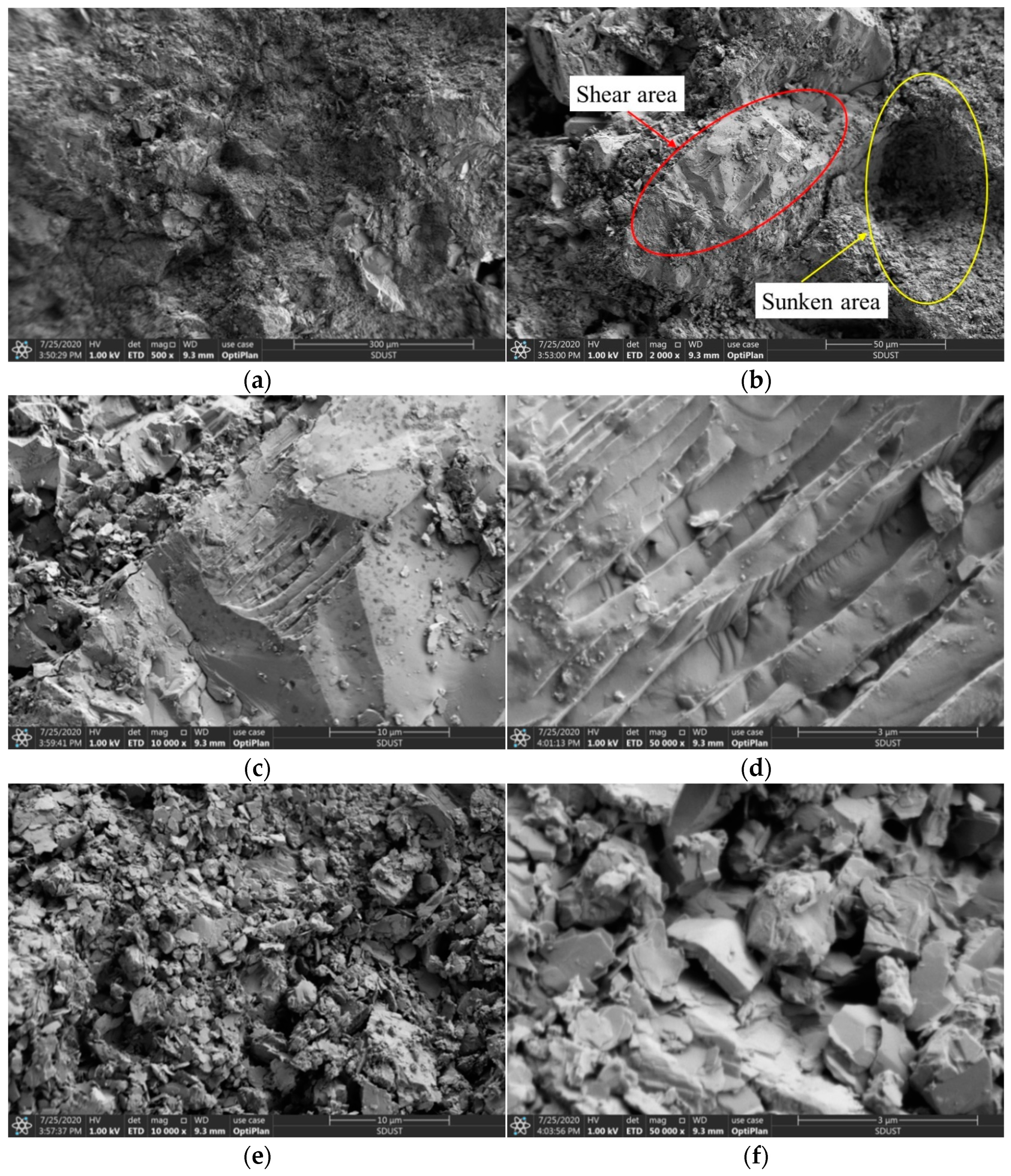
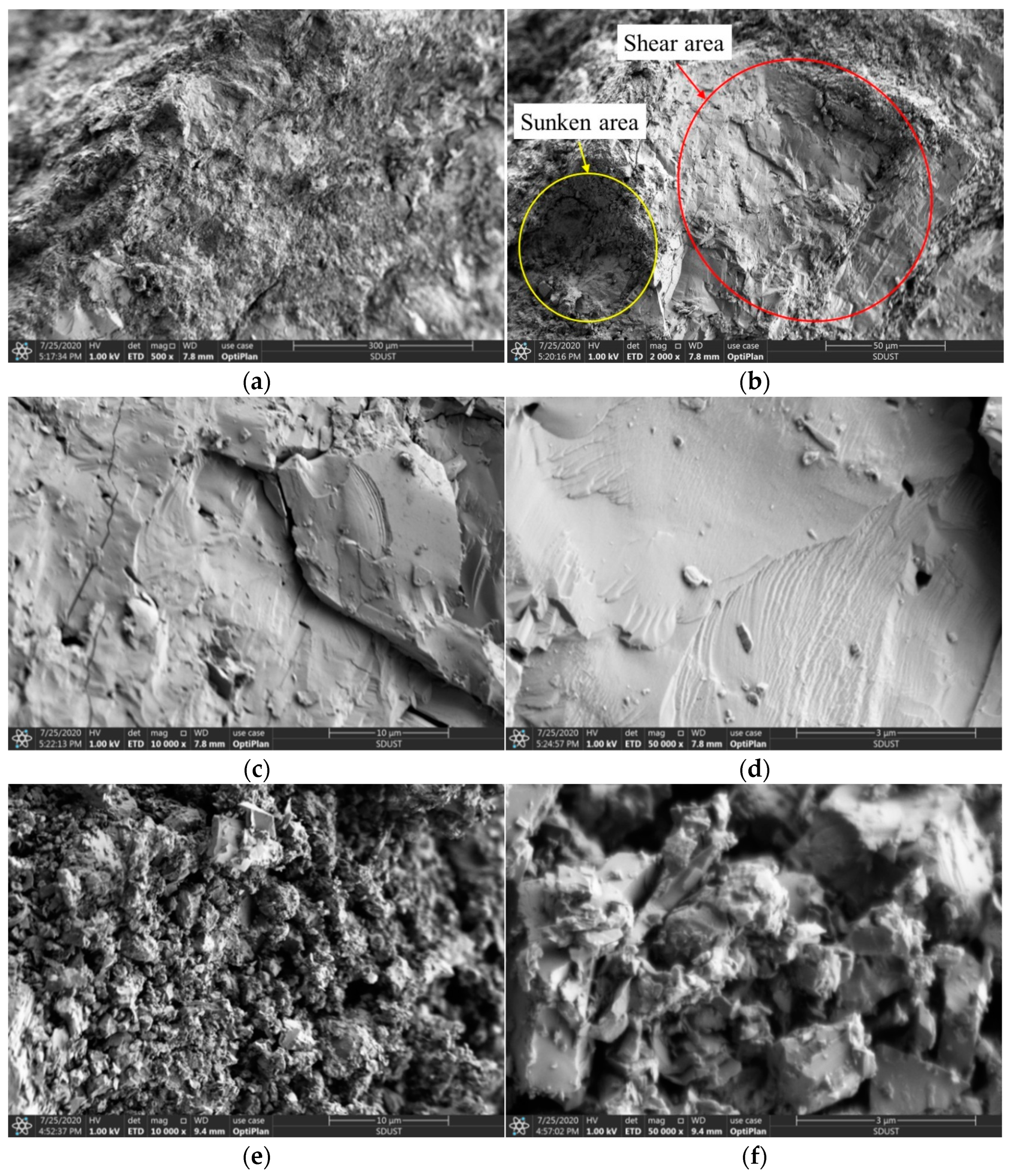
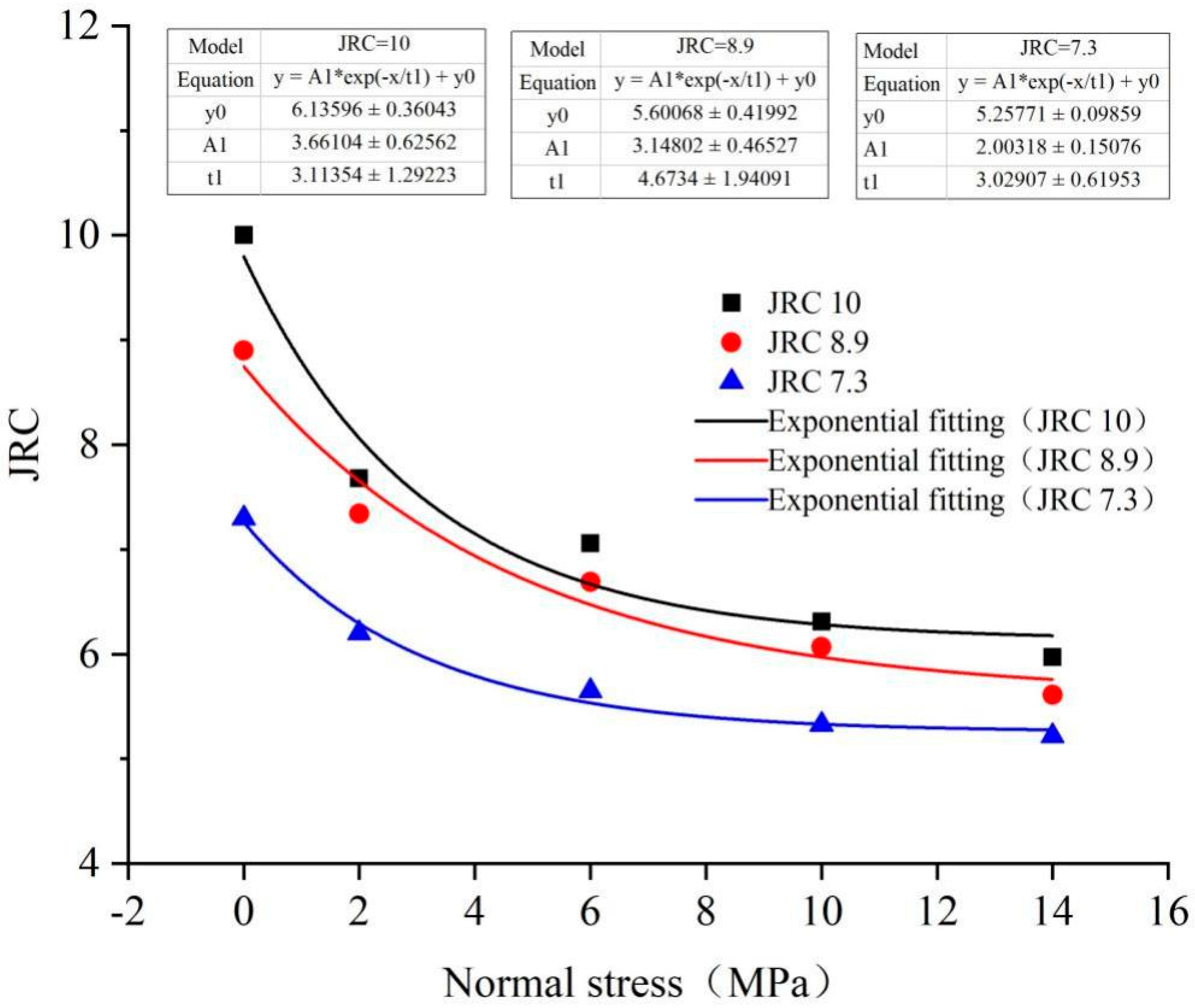
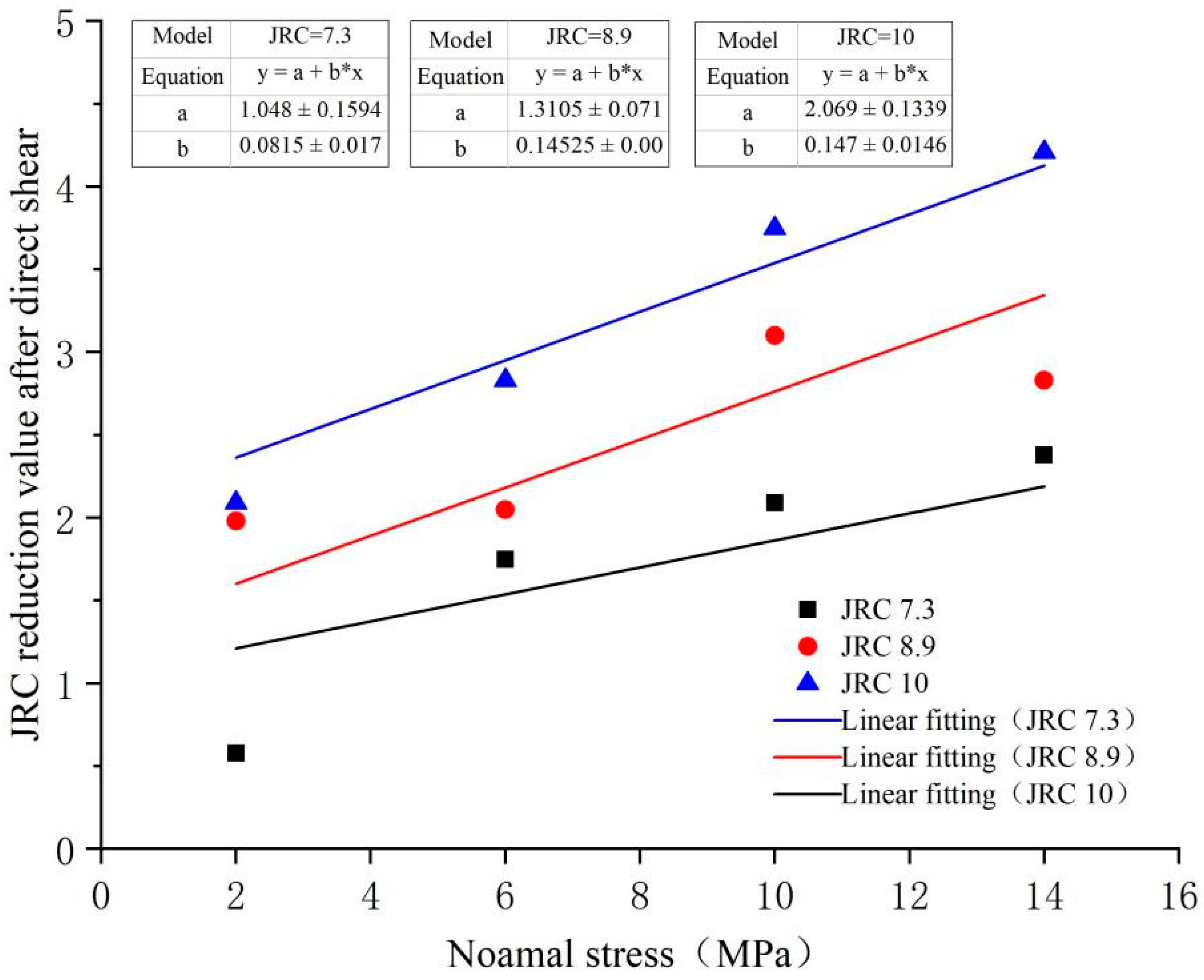
| Group | JRC | Normal Stress (MPa) | |
|---|---|---|---|
| 1 | Average JRC = 7.3 | No. 1, JRC = 6.78 | 2 |
| No. 2, JRC = 7.40 | 6 | ||
| No. 3, JRC = 7.42 | 10 | ||
| No. 4, JRC = 7.60 | 14 | ||
| 2 | Average JRC = 8.9 | No. 5, JRC = 9.32 | 2 |
| No. 6, JRC = 8.74 | 6 | ||
| No. 7, JRC = 9.17 | 10 | ||
| No. 8, JRC = 8.44 | 14 | ||
| 3 | Average JRC = 10.0 | No. 9, JRC = 9.77 | 2 |
| No. 10, JRC = 9.89 | 6 | ||
| No. 11, JRC = 10.06 | 10 | ||
| No. 12, JRC = 10.18 | 14 | ||
Publisher’s Note: MDPI stays neutral with regard to jurisdictional claims in published maps and institutional affiliations. |
© 2022 by the authors. Licensee MDPI, Basel, Switzerland. This article is an open access article distributed under the terms and conditions of the Creative Commons Attribution (CC BY) license (https://creativecommons.org/licenses/by/4.0/).
Share and Cite
Kong, P.; Xing, L.; Xu, C.; Liu, Y.; Zhang, Z. Investigation of Shear Mechanical Behavior and Slip Weakening Characteristics of Rough Joints in Rock Mass. Sustainability 2022, 14, 9654. https://doi.org/10.3390/su14159654
Kong P, Xing L, Xu C, Liu Y, Zhang Z. Investigation of Shear Mechanical Behavior and Slip Weakening Characteristics of Rough Joints in Rock Mass. Sustainability. 2022; 14(15):9654. https://doi.org/10.3390/su14159654
Chicago/Turabian StyleKong, Peng, Luyi Xing, Chuanwei Xu, Yanqing Liu, and Zhongteng Zhang. 2022. "Investigation of Shear Mechanical Behavior and Slip Weakening Characteristics of Rough Joints in Rock Mass" Sustainability 14, no. 15: 9654. https://doi.org/10.3390/su14159654





